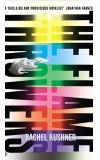
08 Jun 2013 04:03:20
It begins with two motorcycle races, on different continents and decades, but each one is a point of ignition for the rest of the book. The first is in turn-of-the-century Alexandria, where a teenage boy, libidinous and hungry for initiation into the adult world, sees a motorbike for the first time. When he watches the object of his affections mount this contraption and embrace its rider – "man and bike and Marie making an obscene double-humped centaur's profile" – he feels both sexual betrayal and a dangerous elation. "'The world is unknown to me,' he said out loud. 'It is unknown.'" Soon, he's infiltrated a gang of motorcyclists and is racing through the streets with them: "The night felt like it would burn. It was burning. Why had he waited so long? He surged into it."
This is Valera, who goes on to found a motorcycle company. A few pages and many decades later, it's on a Valera motorcycle that Reno, a young woman from Nevada, races across the saltflats. Like Valera, she's surging into her own future, but her ride is both sport and art: she's there to challenge the land speed record, but also to photograph the lines her bike scores across the terrain.
As the book roams – to the rubber plantations of Brazil, for example, where Valera tyres are made – its various settings create a kind of narrative prism, refracting ideas through time and place. Its most substantial and indelible section though, is the downtown art world of 1970s New York. Newly arrived, Reno wanders through this "strange and wondrous and lonely" city, sensing that "what occurred did so because I was open to it, and not because fate and I met at a certain angle".
Kushner has said that "fiction is a space in which you can use naivety to bump up against ambiguities", and this is how Reno functions. Her passivity is partly a narrative necessity, in that we observe this world through her eyes. They are a bewildering crowd, these older, more successful artists, all of whom seem engaged in a complex yet codified wrangling of ego, sexual politics and aesthetic allegiances.
She observes, as one character puts it, like "a little green-eyed cat", "a cat studying mice", but she is also observing herself, a young woman as an object. "I didn't move here to fall in love," she tells Ronnie Fontaine, a magnetic and morally questionable artist. As she says it, though, she feels as if "he'd set a trap of some kind. Because I didn't move here not to fall in love. The desire for love is universal, but that doesn't mean it's worthy of respect. It's not admirable to want love, it just is."
"It just is" also describes the nature of her affair with Sandro Valera, heir to the motorcycle empire. It's as she falls in love with him that she realises, "it was not the case that one thing morphed into another, child into woman. You remained the person you were before things happened to you. [...] You also became the person to whom certain things happened."
There's a quality of iridescence to the writing, particularly in these sections, which isn't just about the lustre of the prose, but the way in which passages seem many-coloured. One thing doesn't morph into another, but many things exist at the same time: tilted one way you see one colour, tilted another, the colour changes.
Later, Reno finds herself once again a "person to whom things happened" when she ends up in Rome. Here, the creative radicalism of downtown New York is matched with the political radicalism of Italy's Years of Lead – the city is in a ferment, on the edge of revolution, and when she's caught up in a march she realises she's both witness and participant.
This is a book supercharged with ideas – futurism, fascism, Autonomia, industrialisation, American land art, pornography – but Kushner's greatest feat is to pull off an overarching radiant coherence without anything ever feeling pat. It's deeply satisfying, too, that a novel so engaged with radicalism doesn't feel the need to experiment radically with form. A formally conventional narrative that's imaginatively incendiary, it makes any fretting over the state of the novel look plain silly.
Early on, Reno is impressed by the "blithe declaration Ronnie once made that he hoped to photograph every living person. Sandro said it was Ronnie's best work and something on the level of a poem: a gesture with no possible rebuttal." This novel can't be mistaken for a gesture. It's also too subtle and too honest to end with an echo of its beginnings – to accelerate to some sort of blazing final crash, metaphorical or otherwise. Its ending is radically ambiguous, the way life is.

